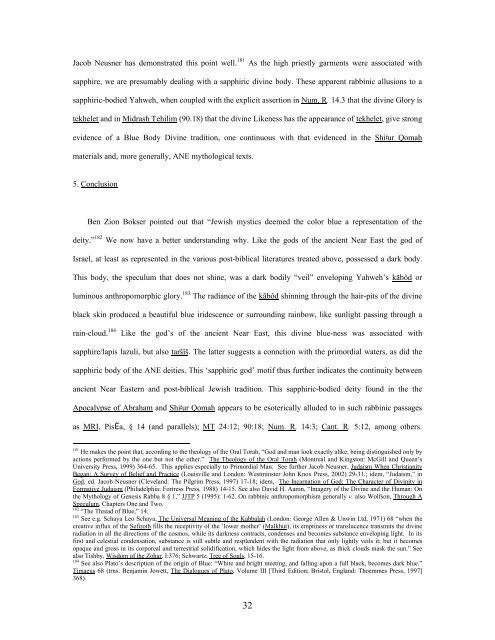Sapphiric God: - Dr. Wesley Muhammad
Sapphiric God: - Dr. Wesley Muhammad
Sapphiric God: - Dr. Wesley Muhammad
You also want an ePaper? Increase the reach of your titles
YUMPU automatically turns print PDFs into web optimized ePapers that Google loves.
Jacob Neusner has demonstrated this point well. 181 As the high priestly garments were associated with<br />
sapphire, we are presumably dealing with a sapphiric divine body. These apparent rabbinic allusions to a<br />
sapphiric-bodied Yahweh, when coupled with the explicit assertion in Num. R. 14.3 that the divine Glory is<br />
tekhelet and in Midrash Tehilim (90.18) that the divine Likeness has the appearance of tekhelet, give strong<br />
evidence of a Blue Body Divine tradition, one continuous with that evidenced in the Shi#ur Qomah<br />
materials and, more generally, ANE mythological texts.<br />
5. Conclusion<br />
Ben Zion Bokser pointed out that “Jewish mystics deemed the color blue a representation of the<br />
deity.” 182 We now have a better understanding why. Like the gods of the ancient Near East the god of<br />
Israel, at least as represented in the various post-biblical literatures treated above, possessed a dark body.<br />
This body, the speculum that does not shine, was a dark bodily “veil” enveloping Yahweh’s kābôd or<br />
luminous anthropomorphic glory. 183 The radiance of the kābôd shinning through the hair-pits of the divine<br />
black skin produced a beautiful blue iridescence or surrounding rainbow, like sunlight passing through a<br />
rain-cloud. 184 Like the god’s of the ancient Near East, this divine blue-ness was associated with<br />
sapphire/lapis lazuli, but also taršîš. The latter suggests a connction with the primordial waters, as did the<br />
sapphiric body of the ANE deities. This ‘sapphiric god’ motif thus further indicates the continuity between<br />
ancient Near Eastern and post-biblical Jewish tradition. This sapphiric-bodied deity found in the the<br />
Apocalypse of Abraham and Shi#ur Qomah appears to be esoterically alluded to in such rabbinic passages<br />
as MRI, PisÈa, § 14 (and parallels); MT 24:12; 90:18; Num. R. 14:3; Cant. R. 5:12, among others.<br />
181 He makes the point that, according to the theology of the Oral Torah, “<strong>God</strong> and man look exactly alike, being distinguished only by<br />
actions performed by the one but not the other.” The Theology of the Oral Torah (Montreal and Kingston: McGill and Queen’s<br />
University Press, 1999) 364-65. This applies especially to Primordial Man. See further Jacob Neusner, Judaism When Christianity<br />
Began: A Survey of Belief and Practice (Louisville and London: Westminster John Knox Press, 2002) 29-31.; idem, “Judaism,” in<br />
<strong>God</strong>, ed. Jacob Neusner (Cleveland: The Pilgrim Press, 1997) 17-18; idem, The Incarnation of <strong>God</strong>: The Character of Divinity in<br />
Formative Judaism (Philadelphia: Fortress Press, 1988) 14-15. See also David H. Aaron, “Imagery of the Divine and the Human: On<br />
the Mythology of Genesis Rabba 8 § 1,” JJTP 5 (1995): 1-62. On rabbinic anthropomorphism generally v. also Wolfson, Through A<br />
Speculum, Chapters One and Two.<br />
182 “The Thread of Blue,” 14.<br />
183 See e.g. Schaya Leo Schaya, The Universal Meaning of the Kabbalah (London: George Allen & Unwin Ltd, 1971) 68 “when the<br />
creative influx of the Sefiroth fills the receptivity of the ‘lower mother’ (Malkhut), its emptiness or translucence transmits the divine<br />
radiation in all the directions of the cosmos, while its darkness contracts, condenses and becomes substance enveloping light. In its<br />
first and celestial condensation, substance is still subtle and resplendent with the radiation that only lightly veils it; but it becomes<br />
opaque and gross in its corporeal and terrestrial solidification, which hides the light from above, as thick clouds mask the sun.” See<br />
also Tishby, Wisdom of the Zohar, I:376; Schwartz, Tree of Souls, 15-16.<br />
184 See also Plato’s description of the origin of Blue: “White and bright meeting, and falling upon a full black, becomes dark blue.”<br />
Timaeus 68 (trns. Benjamin Jowett, The Dialogues of Plato, Volume III [Third Edition; Bristol, England: Thoemmes Press, 1997]<br />
368).<br />
32

















